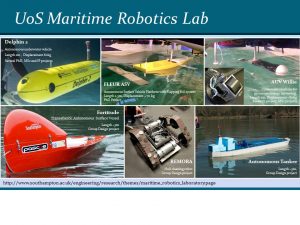Professor Stephen Turnock and Laura Marimon Giovannetti had a busy day on the 7th July talking about the University of Southampton’s experience in engineering excellence in performance sport. Firstly in the afternoon at an event hosted by the Bishop Wordsworth school in Salisbury to an audience of 230 year 10 to year 12 students from four different school’s in the Salisbury area. Then again in a slightly longer format to the IMechE’s Wessex Region as the 11th Annual Arnold Barks Christmas Lecture to an audience of over 100 .
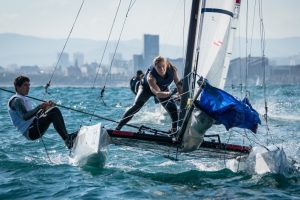
The talk linked the long standing work at Southampton in performance sailing led for nearly five decades by the internationally renowned Wolfson Unit for Marine Technology and Industrial Aerodynamics now based in B185 adjacent to our new 138 m long towing tank, the work on developing F1 and Indy cars in the R.J.Mitchell wind tunnel from the late 70s as well as over a decade of collaboration with UKSport/EIS(R&I) supporting a wide range of sports. The pursuit of performance that ensure that all athletes have the best possible equipment relies on a deep understanding of the physics of the problem coupled to possible engineering solutions. A common thread was the human aspects of the work where able PhD students work alongside sport scientists, coaches and athletes. To date PSEL has graduated 8 EngD/PhD students many of whom have an undergraduate Ship Science degree.
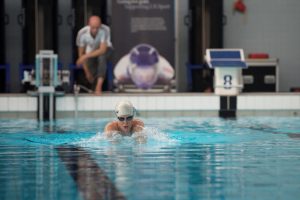
In a final section the relevance of the techniques and technologies developed in performance sport to the wider world and in particular the necessity to find solutions to the essential challenge of improving the energy efficiency of global shipping which transports 90% of the worlds goods, emits 3% of CO2 in 100,000 ships. How will these ships be fuelled in a low carbon world? An example of the cross-over is in Dr Angus Webb whose spin out company Dynamon offers services to the logistics industry.
For both talks the audience asked challenging questions and were in turn asked to spread the word that many more maritime engineering and ship scientists are needed!
All posts by Stephen Turnock
Royal Visit to Towing Tank and FSI Labs
As part of a recent visit to the University of Southampton the Duke of Kent and guests toured our maritime robotics and performance sports labs Building 176 -meeting Dr Joe Banks, Agata Tomaszewska, DrJon Downes and Sophia Schillae.

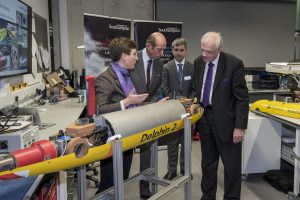
James Bowker and Cath Hollyhead used the wavemakers to demonstrate Fleur’s impressive wave crawling ability- just using wave energy to propel herself into and with the waves.
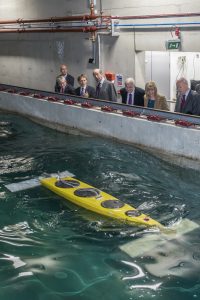
Commissioning of the tank instrumentation continues apace with recent tests on LDV, operation of the new rolling bridge as well as regular use of the Qualisys optical motion capture system. The InnovateUK project led by PlanetOcean associated with the design of an ASV launchable AUV ecoSUB has reached an important milestone with the recent vehicle’s official launch at the NOC. Soon after a prototype was being tested in the towing tank.
GDP 43 Life saving transformers
The Transformers GDP is a team of eight fourth year engineers: seven of whom are mechanical engineers with one aeronautical student. The project is supervised by Dr Nick Townsend from FSI.
Drowning is a huge worldwide problem, which puts thousands of lives at risk every year:
- 372,000 drowning fatalities per year (WHO, 2016),
- 1,000,000 rescues per year (ILSF, 2016),
- Few victims are ever wearing a lifejacket (CDC, 2016).
A frequent risk for lifesavers is being pulled under the water by a drowning person. Therefore, the project intent is to improve lifesaver safety; the robot will save a person from drowning before the lifesaver begins to rescue them from the water. Passive lifesaving robots exist, such as the EMILY robotic buoy (http://emilyrobot.com/portfolio-gallery/photo-gallery/ ), but none exist to actively save lives.
The project aim will be to; design, build and test a working prototype of a marine lifesaving robot, to actively secure casualties in the water. The team will accomplish this by achieving the following:
- Literature review of drowning casualties, existing lifesaving techniques and technology and the human body form whilst drowning,
- Define the anthropometric maxima and minima for an identified human group at risk of drowning for the robotic device to wrap around,
- Design a robotic mechanism to aid lifeguards in securing drowning casualties,
- Research and develop a sensing and control system to allow the device to work semi-autonomously,
- Build a working prototype of the design,
- Perform a realistic, in-depth testing procedure on the device.
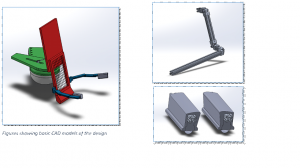
GDP 23: Hydrofoiling Catamaran Experimental Research Platform
In recent years there has been an increasing trend of utilising hydrofoils to reduce drag and enhance the performance of high speed sailing vessels, following the developments of the International Moth class and the AC72s in the 34th America’s Cup. With this current interest growing within the marine industry, it is an exciting opportunity to establish a research platform acting as an interface to effectively carry out experimental testing of innovative hydrofoil technology.
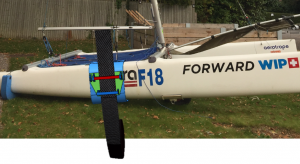
Our aim is to create this research platform by retrofitting a NACRA F18 catamaran using two J-shaped foils to facilitate foiling. In addition, two T-foil rudders will be designed and manufactured from composite materials. A pod system inserted onto the existing daggerboard cases, seen in Fig. 1, will also be developed to attach the J-foils to the side of the boat. The rudders will be designed to have interchangeable wings, allowing for different combinations of main foils and rudder tips to be used. This will permit the investigation into effects of alternative designs. These are the two main features that affect the forces acting on the boat and are therefore very important when developing a foiling craft.

In order to analyse the boat’s response to real world conditions and to collect performance data such as speed, acceleration, roll, rate of turn and foils force, a suitable data acquisition system will also be developed. We aim to provide a good basis for further hydrofoil research to be carried out within the University and hope to encourage more curious minds to pursue naval architecture!
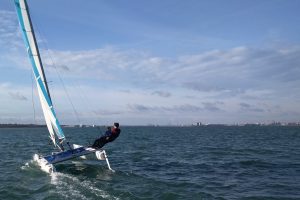
If you want to find out more about the project as it goes forward please visit their facebook page https://www.facebook.com/TheVolantiProject/
Pipefish triumphs at AUV2016
At the start of November, Artur Lidtke (FSI), Daniel Roper (NOC), Georgios Salavasidis (NOC and UoS), Jon Downes (FSI), and Sophia M Schillai (FSI and NOC) headed to Tokyo for the AUV2016 conference.
From newest AUV developments in sensors and navigation to multi vehicle cooperation, the AUV2016 conference covered the current state of the art in Autonomous Underwater Vehicles. Our own contributions ranged from Computational Fluid Dynamics for the EU H2020 Bridges glider project, to vehicle risk and safe navigation of AUV in unknown terrain with restricted sensor input and novel power supply solutions.
Besides presentations, the conference included a demonstration of the impressive AUVs at the University of Tokyo and a student competition for designing a novel AUV, in which Sophia managed to impress the 8 international judges and placed first with her Pipefish AUV.
On the last day, group discussions on the current gaps in AUV development gave us the chance to exchange ideas and get the perspective of experienced AUV researchers from across the world.
After the conference we were given a tour of the headquarters of JAMSTEC (Japan Agency for Marine-Earth Science and Technology), including their newest research vessel KAIMEI, the manned submersible SHINKAI and the 10 m long URASHIMA AUV.
IMAGE CAPTION: Blair Thornton, who has now joined us in Southampton, showing the BOSS-A AUV to Artur and Sophia at The University of Tokyo
Structurally sound awards
On 1st November 2016 Mike Ellis, a Ship Science Graduate, visited Boldrewood to present the Babcock Part 2 Structures Design Award 2016. The winners of this year’s award were Charlotte Dodge and Nathaniel Warren, who both received cash prizes. Highly commended certificates were presented to Xiao Ma, Nadir Wahab and Yifu Zhang. The winners of the award are selected for the high quality of their Structural Design course work submitted for SESS2016, Ship Structural Design and Production.

This module aims to examine aspects of design relevant to the longitudinal and transverse strength of a ship. This is conducted through both first principles design and the use of classification society rules. In addition the production technology applicable to the shipbuilding industry is examined from the perspective of the shipyard and its management but also from a design for production viewpoint. The complementary management module provides production planning and scheduling relevant to ship production.
HIPER looks to future ships

The 10th Symposium on High Performance Marine Vehicles was held in Cortona this October, on the theme “Technologies for Ships of the Future”. Dr. Weymouth represented the University of Southampton and the Fluid Structure Interaction group, giving an invited review on biologically-inspired methods for marine propulsion and maneuvering. There were quite a few interesting talks on biologically-inspired technologies as well; from shark skin and dolphin blubber inspired coatings to squid and flagella inspired underwater vehicles. The proceedings can be found via www.hiper-conf.info
Marine and maritime universities from around the world were in attendance and gave presentations, including academics from the United States (U. Michigan, Florida IT), the UK (Strathclyde, Newcastle, UCL), Europe (NTNU, TU Delft, TUMM, NTUA) and many others. There were also many research and industry groups, from Dell to the US and UK Naval research labs. There were many talks on automation and drag reduction, and the major theme seemed to be increasing maritime vessel efficiency in design, construction, and operation.
Overall the symposium was a great opportunity to renew connections from around the world and any trip to Cortona is a chance to take in the scenery, drink some wine, and even brush up on your pasta making.
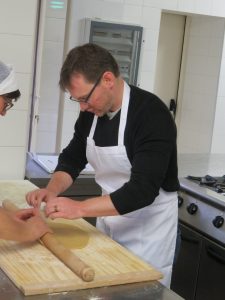
Winning ways rewarded by Wartsila
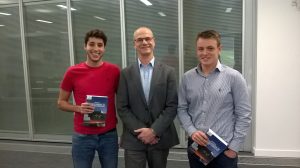
Today John Thornhill of Wartsila UK presented the Ship Design and Economics, Wartsila, General Arrangement Prize to Gilberto Zambrini and Cillian McGreer for their excellent coursework in the SESS2017 Part 2, Ship Design and Economics module.
They each received a copy of Wartsila’s book ; Wartsila Encyclopaedia of Marine Technology along with a certificate which recorded their achievement. Whilst here John took the opportunity to chat with the students about their current design task (Part 3, SESS3024 Marine Concept Design). Generally staff and students were very pleased with the awarding of this prize which aknowledged hard work and thoughtful design.
Greenwich Forum Prize for the 2016 Best Undergraduate Project/Dissertation
University of Southampton Ship Science students continue to excel at National level with the Greenwich Forum prize for the 2016 best undergraduate project/dissertation awarded to Xiaoming Yang. Her work was judged the best out of a strong field of seven and dealt with the important topic of parametric roll which has been a concern for certain categories of large ships in recent years. Xiaoming graduated as top of her class with a BEng in Ship Science in June 2016.
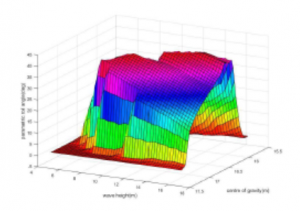
Our wave energy powered AUVs and ASVs systems presented at OCEANS16
At the end of September FSI PhD student and Ship Science MEng graduate James Bowker and Dr Nick Townsend presented their research at the OCEANS16 conference in Monterey, California.
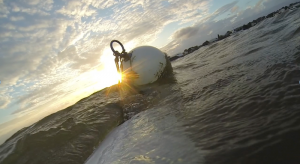
The conference which featured over 500 technical presentations and industrial exhibitions was a real show case of latest ideas and innovations in marine technology. There were sessions on autonomous vehicle design, navigation, control, communication, sensors, imaging, and hydrodynamics – every abbreviation you could think off ASV, AUV, UAV, UUV, ROV!
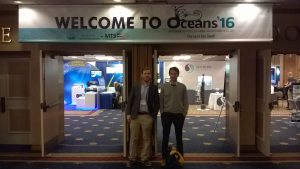
James and Nick presented their research which is exploring and developing new energy scavenging technologies that can augment and power autonomous marine vehicles such as AUVs, ASVs and potentially boats and ships.
James’ paper “Experimental analysis of submerged flapping foils; implications for autonomous surface vehicles (ASVs)” explores the use of submerged or tandem flapping foils as a mechanism to convert ocean wave energy directly into propulsion or to generate power and recharge the platform.
Nick’s paper “In situ results from a new energy scavenging system for an autonomous underwater vehicle” explores capturing the undesired wave induced motions (roll and pitch) of a floating platform through a gyroscopic system.
